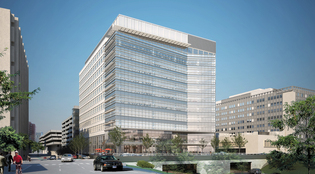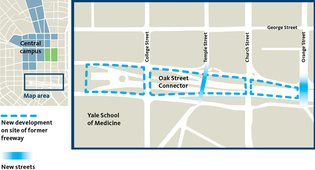 loading
loading
New HavenOnly connectThe city looks to undo a postwar planning mistake.  Elkus Manfredi Architects.The Downtown Crossing project will replace much of a sunken freeway with new development, including a biotech building (illustrated) at 100 College Street. View full imageBefore it was renamed for its creator, former New Haven mayor Richard C. Lee, it was known as the Oak Street Connector. But the sunken, mile-long stub of 1960s freeway leading from Interstate 95 to downtown New Haven is as much a divider as a connector, separating downtown and the central Yale campus from the Yale–New Haven medical center and the Hill neighborhood. Now, New Haven is spending millions of dollars in city, state, federal, and private funds to replace much of the highway with surface streets and new development sites. The city says in promotional materials that the redeveloped ten-acre site, known as Downtown Crossing, will have “a unique, livable, and authentic sense of space.” As the hospital and medical school have grown, “their ability to create an active place is deeply impacted by this highway and the lack of connection back to downtown,” says city official Michael Piscitelli. Downtown Crossing “starts to stitch the city back together.” In place of the current six-lane highway and frontage roads will be a pair of boulevards with slower vehicular speeds, bike lanes, and wide sidewalks to promote pedestrian traffic. The first phase, which will cost $30 million and begin this year, will close a four-block length of the highway, says Piscitelli.
 Mark Zurolo ’01MFAView full imageBoosters like Piscitelli say Downtown Crossing will help entice students and professionals to work and live in New Haven, but the project has its detractors. “We are rather disappointed,” says Anstress Farwell ’78MA, president of the New Haven Urban Design League, who thinks the plan is still too auto-oriented. “We’re still building with the sorts of ideas of the 1950s,” she says. “We’re getting a ‘stroad’—a combination of street and road—with few of the amenities you’d associate with a street.” Alex Garvin ’62, ’67MArch, a Yale adjunct professor of urban development, says removing the highway will be an improvement—but the project isn’t likely to unite the two sides without the addition of pedestrian street-level activity. The first test of the project will come with the construction of an 11-story, 400,000-square-foot office and laboratory building at 100 College Street—just east of the Air Rights Garage, which straddles York Street next to the hospital. Developer Carter Winstanley has found an anchor tenant for the project in Alexion Pharmaceuticals, which will move its headquarters there from Cheshire, Connecticut, in 2015. The $140 million project will have shops at the street level.
The comment period has expired.
|
|